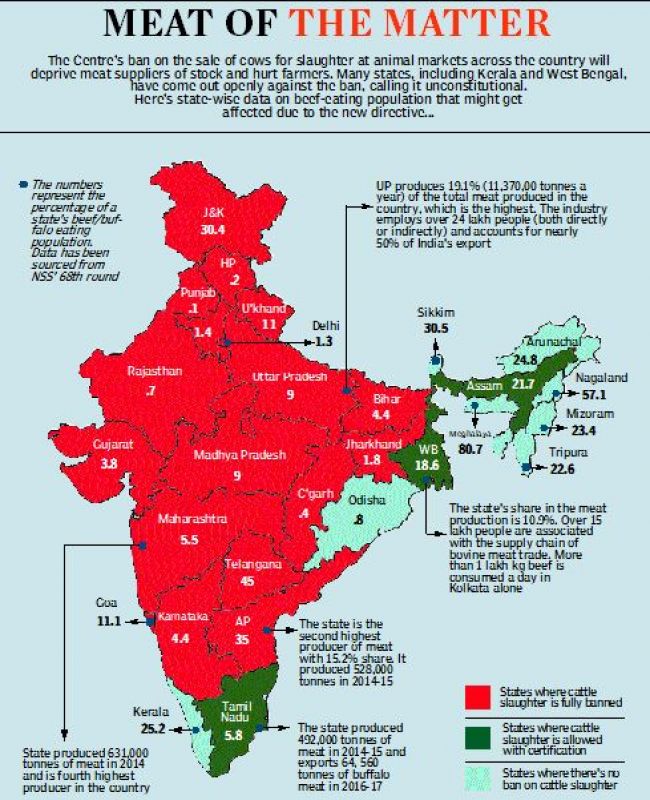Farmers biggest losers as $5 million industry reels

The recent ban on the sale of cattle for slaughter in agricultural markets has led to much debate on the freedom of choice on food and religion. But the biggest implication will be on the multi-million dollar industry dependent on cattle for its existence, including dairy, meat and leather production and trade.
The enviroment and forests ministry had notified the Prevention of Cruelty to Animals (Regulation of Livestock Markets) Rules 2017, banning trading in cattle (cows, bull, buffalo and camel) for slaughter at animal markets, sometime last week. The Madras high court has ordered a four-week stay on the ban as of now.
Experts value the cattle trade industry, which includes all three components of dairy, leather and meat, at around $5 million.
There are numerous other byproducts which will also be affected like pharmaceuticals, poultry feed, paintbrush and handicraft industry. Of this, export in both buffalo meat and in leather products have declined in 2016-17 for the second straight year. Exporters say global markets are responsible for the fall in the last two years, but if the environment ministry’s new rules aren’t changed, the slump can be a massive one.
In the entire spectrum, the meat business will be the most affected as 90-95 per cent of cattle is procured from the markets. If the markets don’t function, it will have an adverse impact, as 90 per cent of the supply comes from the markets.
The biggest losers will be the farmers as feeding animals is a day-to-day burden. Government statistics show that the average income for marginal and middle-income farmers in India is a little over Rs 1 lakh a year. Of that, if he sells one buffalo for meat, he gets Rs 30,000-35,000, which is a lot of money for him. The second rung to be affected are employees, which are more than 25 lakh.
The ban has been questioned by many state governments and the Opposition parties for infringing on the federal rights of states as well as dictating people’s right to food of their choice.
West Bengal chief minister Mamata Banerjee has even threatened to go to court. Kerala and Tamil Nadu, the two major beef-eating states apart from the Northeast, have seen large-scale protests. Kerala chief minister Pinarayi Vijayan has even called for a conclave of chief ministers to discuss the issue.
‘Beef rule’ fallout
On May 23, the environment ministry put out a notification banning the sale cattle for slaughter to livestock markets across the country.
PROTESTS
Soon after the notification, protests erupted across large parts of states such as Kerala, Tamil Nadu and West Bengal.
On May 31, Kerala CM Pinarayi Vijayan called a meeting of all chief ministers against the order.
Bernard Marak, a BJP leader from Meghalaya, said all party leaders in the state eat beef and the ban wouldn’t be applicable there. A day later, he quit the party.
BEEF FESTS
After the Centre’s announcement, ‘beef fests’ were held in Kerala and TN
A video shot during one such beef fest showed Congress workers publicly slaughtering a calf in Kerala. The party suspended 3 workers over the incident.
Right-wing activists severely thrashed a student of IIT-Madras who was involved in a beef fest organised at the campus eariler.
LEGAL HIGHLIGHTS
On May 30, the Madras HC stayed the notification on cattle sale, saying it was against the Consti-tution and the principles of federalism.
On May 31, Kerala HC refused to entertain a PIL against the notification, saying it didn’t violate the Constitution. Rajasthan HC, on May 31, asked the Centre to make cow the national animal
CENTRE CAUTIOUS
Amid protests, the Centre explained that it had not banned cow slaughter, but only the sale of cattle to slaughter houses. On June 1, Arun Jaitley faced the media to defend the new rules


